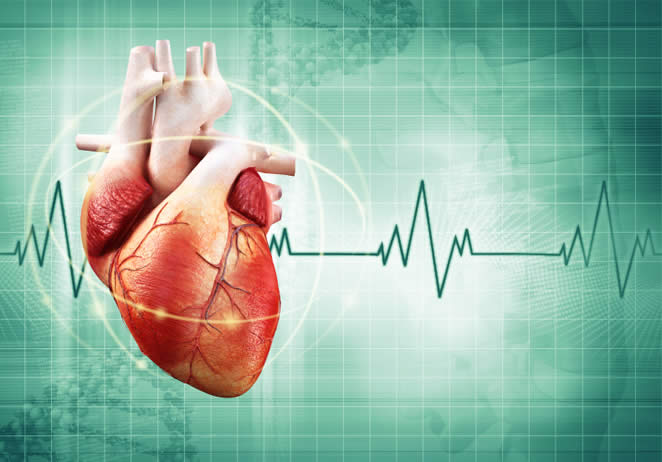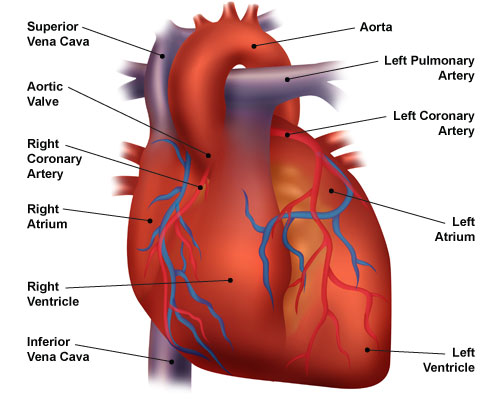Know your Heart - Heart Structure and Function
- Is a muscle about the size of your fist.
- Weighs approximately one pound.
- Is located behind and slightly to the left of the breastbone.
- Pumps about 5 quarts (4.7 liters) of blood every minute or 1800 gallons (6768 liters) of blood every day.
The function of the heart is to circulate blood throughout the body.
- Pumping blood through the lungs removes carbon dioxide and refreshes the blood with oxygen.
- The oxygenated blood is pumped to the body to provide oxygen and nutrients, and to remove waste products.

A healthy heart beats steadily and rhythmically at a rate of about 60 to 100 beats per minute when at rest (normal sinus rhythm). During strenuous exercise, the heart can increase the amount of blood it pumps up to four times the amount it pumps at rest, within only a matter of seconds.
The heart's structure has four chambers with one-way flaps called valves. The atria are the upper chambers and they receive blood that is being returned to the heart. The right atrium receives blood with little oxygen because the blood has already circulated throughout the body delivering oxygen and nutrients.
The left atrium fills with newly oxygenated blood returning from the lungs. When the atria pumps (contract), they push the blood through valves (tricuspid and mitral) into the relaxed ventricles. When the ventricles contract, the right ventricle pumps blood through the pulmonary valve into the lungs. The left ventricle pumps blood through the aortic valve to the body, including the heart (through coronary arteries). This continuous cycle of synchronized contractions is driven by the heart's electrical system.

Although the heart is bathed in blood, it cannot derive its own nutrition from the blood it is continuously pumping. For its own oxygen and nutrients, the heart depends on blood from 3 arteries. These coronary arteries arise from the aorta and include the right coronary artery (RCA) and the left main coronary artery (LMCA) which in turns divides in to two branches: the left anterior descending coronary artery (LAD) and the left circumflex coronary artery (LCx). The LMCA is the most important artery of the heart supplying almost 70-80 % of blood to the heart's muscle. Of this the LAD accounts for approximately 50% of the heart's blood supply, and the LCx for 20-30%. The remaining 20-30% of the heart's blood supply comes from the RCA. An occlusion (blockage) of the LMCA is almost always fatal. LAD blockage is next in seriousness, and results in severe damage to the heart. Occlusions of the RAC and LCx, or smaller side branches of any of the coronary arteries are usually less dangerous and result in a heart attack of variable size and severity, depending on the artery, which is blocked.
- A HEALTHY CORONARY ARTERY : A healthy artery is normally smooth-walled. Blood flows through it easily without any turbulence. Healthy coronary arteries provide the heart with sufficient blood both during rest and when the heart's demands are raised e.g. during exercise.
- ATHEROSCLEROSIS : This is scientific name for the process of hardening of the coronary arteries. The process of atherosclerosis is a universal process of ageing (like the age related whitening of our hair). It occurs in everyone to some extent with advancing age. Atherosclerosis begins from early childhood by deposition of cholesterol and other fatty substances (called fatty plaques) in the wall of the arteries. This process goes on during an individual's life, slowly in some and faster in others.
- A NARROWED AETERY : With time, these fatty plaques grow in size and harden, which may lead to a narrowing of the coronary arteries, somewhat like scale formation on the inside of a metal water pipe. When the coronary arteries become narrowed by more than 70%, the amount of oxygen reaching the heart muscle may not be enough to meet its demands. This inadequacy of blood supply becomes especially significant when the heart must work harder as during exercise, stress, after food etc. It is then that the heart muscle cries out in pain, which is called angina pectoris.
- A BLOCKED ARTERY : If blood flow is completely blocked in the artery by a plaque, or a blood clot (thrombus) forming within the narrowed artery, the heart muscle supplied blood by this artery does not receive any blood and starts to die. This leads to a heart attack. The blockage of the artery can occur as the result of a gradual build up of cholesterol within the artery over several years. A slowly developing occlusion may give time for the heart to compensate for the blockage by the development of small alternate pathways called collaterals. These collaterals are a boon for the heart, and may even prevent a heart attack when this slowly narrowing artery finally occludes. Another way that an artery may get blocked is when a small and often insignificant plaque becomes unstable and ruptures. Rupture of this unstable plaque may occur due to stress, excitement, exercise, or sudden rise of blood pressure. Plaque rupture results in a loss of the normal smooth lining of the arterial wall, which in turn induces thrombus formation. Since the occlusion in this case is abrupt, there is no opportunity for collaterals to develop and the resultant heart attack is invariably larger than if the occlusion had been more gradual.
RISK FACTORS OF CORONARY ARTERY DISEASE
- NON-MODIFIABLE (THAT YOU CANNOT CHANGE):
- We are committed to helping everyone – rich, poor, old, young, near and far.
- FAMILY HISTORY
- AGE
- GENDER (MALE and FEMALE)
MODIFIABLE (THAT YOU CAN CHANGE)
- SMOKING (Directly responsible for at least 20% deaths from heart diseases)
- CHOLESTEROL
- HIGH BLOOD PRESSURE
- DIABETES (60% Deaths from heart attack)
- OBESITY: A 2000 study reported that men who have waist that measure more than 36 inches & have triglyceride levels (more than 200 mg%) are at high risk of developing heart diseases within 5 years.
- EATING HABITS
- SEDENTARY LIFESTYLE (twice as likely to have heart attack)
- STRESS/DEPRESSION
Angina is a direct consequence of atherosclerosis (hardening) of the coronary arteries. Atherosclerosis is a slowly developing process in which cholesterol and other fatty substances are deposited in the wall of the arteries, somewhat like scales forming on the inside of a pipe. Atherosclerosis is a normal ageing process (like the whitening of hair) and occurs in everybody to some extent with growing age. However, in some people, this process is more pronounced and the inside of the artery gets narrowed, impeding normal blood flow. This is the stage when one may experience warning symptoms in the form of chest pains (angina pectoris).
- WHAT IS ANGINA PECTORIS?
Angina is the heart muscle's complaint that it is not getting enough oxygen. Angina literally means 'choking'. Angina pectoris is the term used to denote the suffocating discomfort in the chest owing to the heart receiving less oxygen due to a narrowed coronary artery.
- Location of the pain
The typical pain in the left side of the chest radiating to the left arm, neck and back almost confirms angina.
- Trigger factors for the pain
Angina pain is very typically related to physical exertion and is relieved by rest. However, there are exceptions to this pattern.
- Types of pain
Most people complain of heaviness or tightness in the middle of their chest. Some of them may feel uneasiness or suffocate. Diabetic patients may not experience the typical chest pain and often complain of uneasiness or breathlessness. This is basically because they lose the pain sensation due to nerve damage caused by diabetes.
- Severity of pain
Based on the severity, angina is classified into Class- 1, where the patient gets the symptom after severe exertion like running, walking uphill, carrying weight. Class- II, where the patient can walk up to 1-2 Km without symptoms Class- III, angina is brought on by slight exertion. Class IV, is when angina occurs at rest.
- Importance of Early detection of Heart disease
Fifty million Indians suffer from one or more types of cardiovascular disease, the most common of them being Coronary Heart Disease (CHD). Not all are patients. Most of them are individuals who go about their day-to-day activities not knowing that they suffer from heart disease. Unfortunately, expensive and often life-threatening invasive procedures have been the mainstay for the prevention and management of CHD. Early diagnosis and treatment of CHD is presently not being given the focus it actually needs.
Q : What are other imaging tests that are available?
A : The following tests are invasive and require a needle to be punctured in the vein.
- Stress test.
- PET test. MUGA scan
- Thallium stress test
- Pharmacological
The following tests may require insertion of a catheter
- Trans-esophageal echocardiogram (TEE)
- Cardiac catheterization – also known as Coronary Angiography (CAG)
- Intravascular ultrasound.